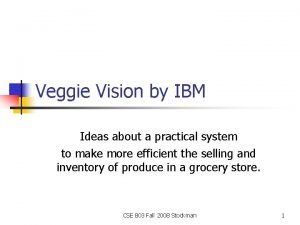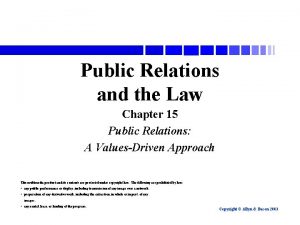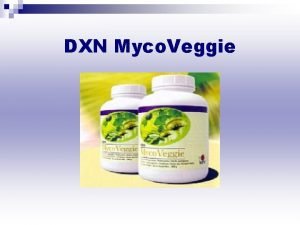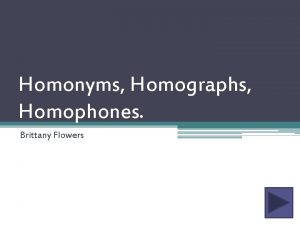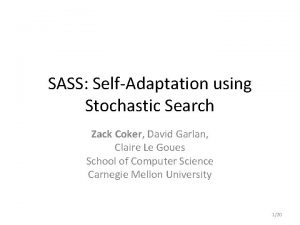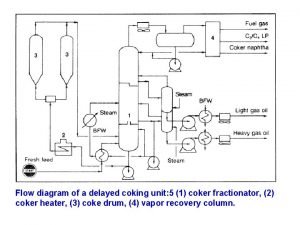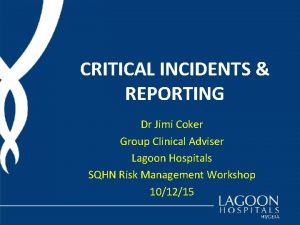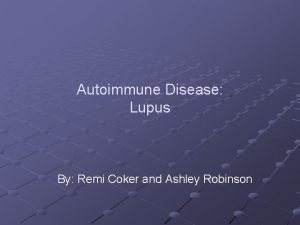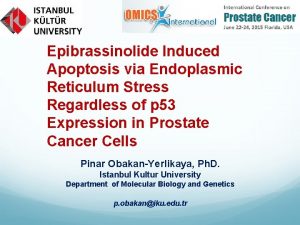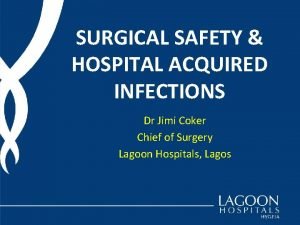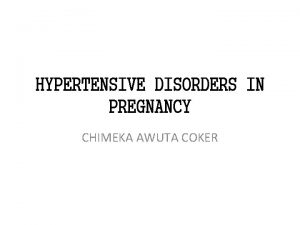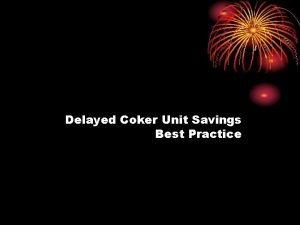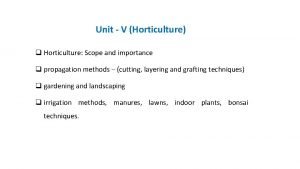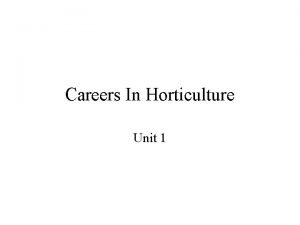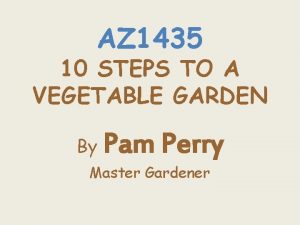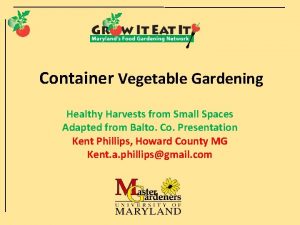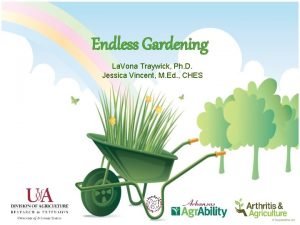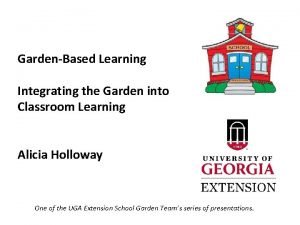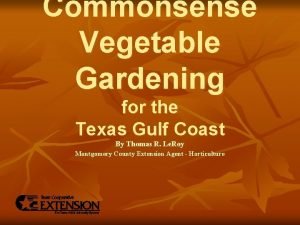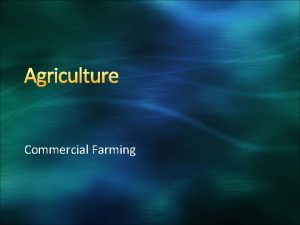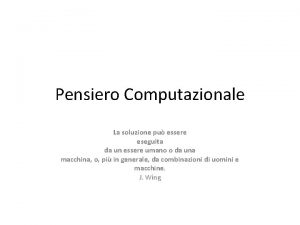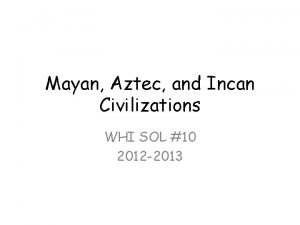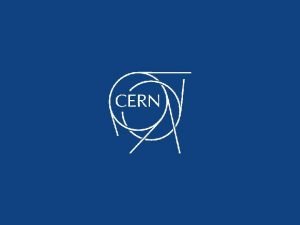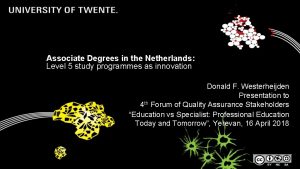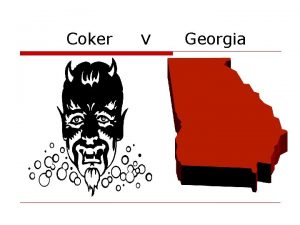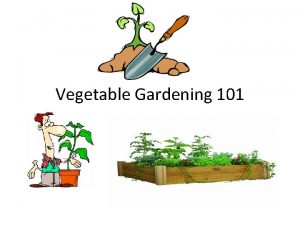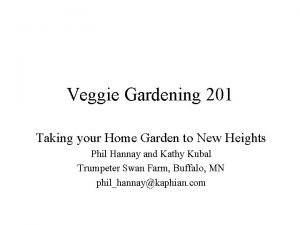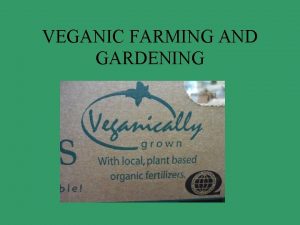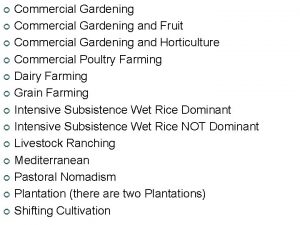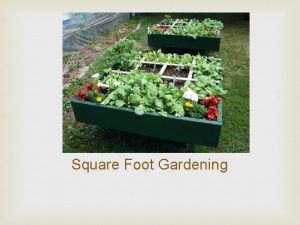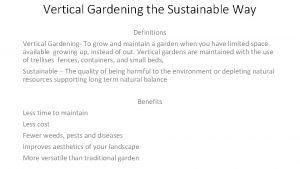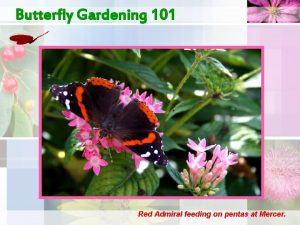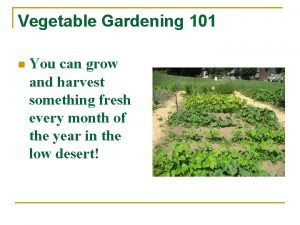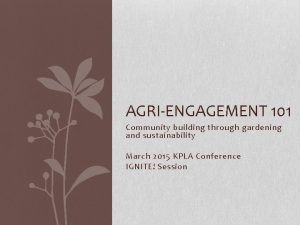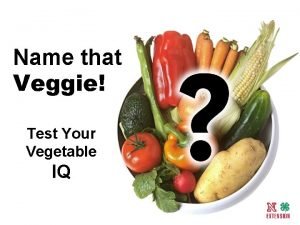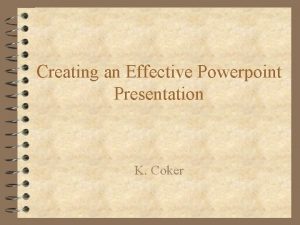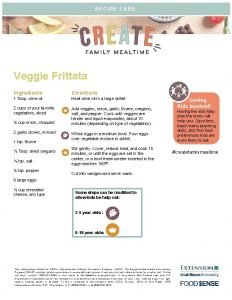Veggie Gardening 101 Dr Christine Coker Associate Research











![Minerals Essential elements – 1. Required for complete life cycle • [seed to seed] Minerals Essential elements – 1. Required for complete life cycle • [seed to seed]](https://slidetodoc.com/presentation_image_h/c6adf8b5f0efcb4c593cac53d026d599/image-12.jpg)
![Macronutrients Present in “large” quantities [% vs. ppm] – – – Nitrogen – N Macronutrients Present in “large” quantities [% vs. ppm] – – – Nitrogen – N](https://slidetodoc.com/presentation_image_h/c6adf8b5f0efcb4c593cac53d026d599/image-13.jpg)



























- Slides: 40

Veggie Gardening 101 Dr. Christine Coker Associate Research and Extension Professor of Urban Horticulture L/O/G/O

Garden Considerations L/O/G/O

Ask yourself • What do I want to plant? • How big should my garden be? • Where should I put my garden?

What to Plant Select vegetables and the amount to plant by looking forward to harvest and how you will use the vegetables.

Garden Size • Family size • Amount of vegetables you need (or want) • Will you preserve or use most of your vegetables fresh? • Available time and equipment • Physical ability

Garden Location • • Close to the house Full sun Near a water supply Well-drained

The Basics L/O/G/O

What do plants need? • H 2 O • Light • Minerals

Water • Water is the major constituent of plant tissue. • Medium in which cell metabolic processes occur. • Medium for transport between cells in plant tissues and organs.

Light • Light is required for photosynthesis. • Day length (actually length of the dark period) is important for some plants. • Long-day plants – Spinach, Chinese cabbage, some radishes • Day-neutral plants – Tomatoes, squash, beans

Minerals • Besides water, soil is the main source of plant nutrients. • Excessive amounts – toxicity • Deficiency – poor and/or abnormal growth
![Minerals Essential elements 1 Required for complete life cycle seed to seed Minerals Essential elements – 1. Required for complete life cycle • [seed to seed]](https://slidetodoc.com/presentation_image_h/c6adf8b5f0efcb4c593cac53d026d599/image-12.jpg)
Minerals Essential elements – 1. Required for complete life cycle • [seed to seed] – 2. Lack causes a particular symptom – 3. Re-introduction relieves symptom – 4. Has a known chemical function within plant
![Macronutrients Present in large quantities vs ppm Nitrogen N Macronutrients Present in “large” quantities [% vs. ppm] – – – Nitrogen – N](https://slidetodoc.com/presentation_image_h/c6adf8b5f0efcb4c593cac53d026d599/image-13.jpg)
Macronutrients Present in “large” quantities [% vs. ppm] – – – Nitrogen – N – 2 -6% Phosphorus – P – 0. 15 -0. 6% Potassium – K – 2 -6% Calcium – Ca – 0. 5 -2. 5% Magnesium – Mg – 0. 15 -0. 6% Sulfur – S – 0. 15 -0. 6%

Micronutrients • • Manganese – Mn – 100 -300 ppm Iron – Fe – 50 -150 ppm Chlorine – Cl – 10 ppm Copper – Cu – 2 -5 ppm Boron – B – 30 -60 Zinc – Zn – 100 -300 Molybdenum – Mo – 0. 01 ppm qppm = parts per million q 1 mg/L = 10, 000 ppm

Get a soil test!

Planting Times L/O/G/O

Spring • • Onions Cabbage Lettuce Corn Tomatoes Peppers Eggplant

Summer • • • Lima beans Squash Cucumbers Peas Okra

Fall • • Spinach Mustard Turnips Cauliflower Carrots Broccoli Beets Collards

Vegetables L/O/G/O

Vegetables are food. • White (Irish) potato is the most consumed vegetable in developed countries followed by tomatoes and cabbage. • In developing countries, starchy root and tuber vegetables are the most consumed commodities. • Also important: plantain, onion, watermelon, tomato

Edible Plant Parts

Leaf • • • Collards Lettuce Cabbage Spinach Kale

Flowers • Broccoli • Cauliflower

Mature Fruit Tomato Pepper Eggplant Watermelon Cantaloupe Pumpkin

Immature Fruit Cucumber Squash Okra

Stems Asparagus Irish potato

Buds Brussels sprout Onion Leek

Roots Sweetpotato Carrot Radish

Recommended Veggies for Small Spaces • • Bush Bean Lima Bean Broccoli Cabbage Carrot Cauliflower Swiss Chard Cucumber • • Eggplant Lettuce Onion Pea Pepper Pumpkin Summer Squash Tomato

MSU Trials at the Beaumont Horticultural Unit Perry County, MS L/O/G/O

Grape Tomatoes

Asian Eggplants

Asian Cucumbers

Bitter Melon (Bitter Gourd)

Pumpkins

Garden Tabloid Publication 1091 L/O/G/O

You can follow me! Pinterest pinterest. com/veggiedr & Twitter @veggiedr & Word. Press veggiedr. wordpress. com

Follow Coastal Research and Extension Center Facebook facebook. com/Coastal. Rand. ECenter

Save the Date! Vegetable Field Day Beaumont Horticultural Unit June 12, 2014
 Veggie vision
Veggie vision Veggie libel laws
Veggie libel laws Dxn mycoveggie side effects
Dxn mycoveggie side effects Homophone of present
Homophone of present Vertical farming
Vertical farming Describe lee coker and amos hicks
Describe lee coker and amos hicks Zack coker
Zack coker Delayed coker unit process+flow diagram
Delayed coker unit process+flow diagram Ats coker
Ats coker Remi coker
Remi coker Ajda çoker gürkan
Ajda çoker gürkan Jimi coker
Jimi coker Coker definition
Coker definition Coker heater
Coker heater Von thunen model ap human geography definition
Von thunen model ap human geography definition Scope of horticulture
Scope of horticulture Objectives of gardening
Objectives of gardening Intensive farming ap human geography
Intensive farming ap human geography Container vegetable gardening in arizona
Container vegetable gardening in arizona Intertillage ap human geography
Intertillage ap human geography Paddy madden school garden
Paddy madden school garden Ohio state extension gardening
Ohio state extension gardening Dewey decimal system gardening
Dewey decimal system gardening Gardening soil mix
Gardening soil mix Gardening with arthritis
Gardening with arthritis Paddy madden gardening
Paddy madden gardening Gulf coast vegetable gardening
Gulf coast vegetable gardening Commercial farming
Commercial farming Mbcs membership
Mbcs membership Promotion from associate professor to professor
Promotion from associate professor to professor Tecniche associate al pensiero computazionale:
Tecniche associate al pensiero computazionale: Inca civilization
Inca civilization Lonestar nursing prerequisites
Lonestar nursing prerequisites Certified systems engineering professional
Certified systems engineering professional What is the drawback of direct mapping?
What is the drawback of direct mapping? Pjas cern
Pjas cern Associate degrees in the netherlands
Associate degrees in the netherlands Associate consulting engineers
Associate consulting engineers Jeannie watkins
Jeannie watkins Rcog eportfolio
Rcog eportfolio Associate degree duo gift
Associate degree duo gift
